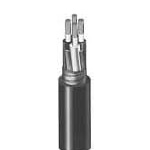Multiconductor Portable Cord
Multiconductor cables play a big part in our lives. There are very few places in a house where no cables are installed unless that room does not use any electricity. Everything from the porch to the living room and bathroom uses wires and cables to keep things running and provide us with modern capabilities. We get to eat comfortably, watch our favorite shows and do practically anything we need to do around the house because wires and cables are in their proper places.
Even outside the home, we use devices that depend on cables, such as phones, laptops and cars. Identifying the different types of cables and how and where they are supposed to be used can be very useful skills. Let’s take a closer look at the different types of multiconductor portable cords and their applications.
Types of Multiconductor Portable Cord
Between the many types of multiconductor portable cords on the market, it’s helpful to know how they compare, so you can select the right one. These options include:
- Service, junior, oil-resistant and weather/water-resistant (SJOOW) cable. SJOOW is a heavy-duty cable good for indoor and outdoor applications, thanks to its durable construction. The “junior” designation means it supports up to 300 volts. Temperature capabilities run from -40 to 90 degrees Celsius.
- Service, oil-resistant and weather/water-resistant (SOOW) cable: This cable is similar to SJOOW but lacks the “J” because it’s the older brother to SJOOW, offering 600 volts of power. It works for similar situations and in temperatures from -40 to 90 degrees Celsius that call for more power.
- Type W cable: Type W cable is a single-conductor cable with excellent resistance to abrasion, sunlight, oil and water, with great flexibility. That’s because of its dual insulation made of ethylene propylene diene monomer (EPDM) and Super Vu-Tron® materials, as well as polyester braid reinforcements for added mechanical strength. It can carry 2,000 volts in temperatures up to 90 degrees Celsius, making it popular in some mining and industrial applications, as well as motor and battery leads.
- Type G and G-GC cable: Type G and G-GC cables are types of SOOW cables, but they include a ground wire for each conductor. Type G-GC cables have an additional ground-check wire in the cable. Both use chlorinated polyethylene jackets and EPDM insulation for durability and flexibility. They’re also great for portable applications since they can be rolled, walked on and folded up for easy storage. They work in temperatures from -40 to 90 degrees Celsius and support up to 2,000 volts.
Knowing the different types of multiconductor cables and where they are supposed to be used is important for choosing the right type of wire for each project. This knowledge is useful even if you’re not completing the job.
For instance, when a repairman comes to do a few odd jobs, knowing some basics about the wires can help them determine what they need to buy or bring with them. With some information on wires and cables, you can also be more prepared to handle emergencies on your own.
WesBell Electronic’s Multiconductor Portable Cords
At WesBell Electronics, we carry multiconductor portable cords made of high-quality materials and available by the foot, so you can buy the right quantity for your project. We also offer many wire processing services, such as cutting and stripping, so you can get straight to work when the cable reaches the job site.
Our expert representatives understand the ins and outs of multiconductor cables and can walk through your project to help you determine which is right for your application.
Click our product links to explore our multiconductor portable cords, and reach out to us for more information!








